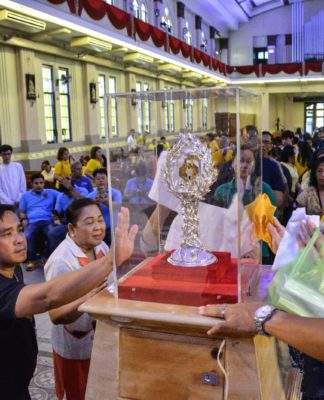“Science without religion is lame,” Einstein once said. “And religion without science is blind.” But has science already acknowledged Einstein’s advice for the sake of humanity?
Modern medicine is now slowly taking a walk down memory lane as it travels back to a time when priests and shamans cured the sick by studying the link between faith and healing.
Based on a 2002 survey from the U.S.-based National Institutes of Health, the most popular form of alternative medicine in America is prayer, followed by acupuncture, chiropractic care, and yoga.
But prayer, now being considered a notable area in modern medicine, still needs strong evidence to back its claims as scientists believe there is still no direct link between prayer and physical healing.
Professor Marc Erik Reyes of the UST College of Science Department of Psychology explains that prayer can affect physical health through the mental state.
“Prayer brings about meditation, which brings about a certain level of relaxation that could help boost our immune system,” Reyes told the Varsitarian.
Dr. Dale Matthews, author of The Faith Factor (1998), suggests that “faith helps people prevent illnesses, recover from sickness, and live longer” through several factors based from different studies. Most significant is that religiously active people live healthier lifestyles that limit the development of diseases, like avoiding alcohol, smoking, substance abuse, and risky sexual behaviors.
In 1997, a similar study of 6,982 people by Dr. W.J. Strawbridge found that regular churchgoers have 36 per cent lower mortality rates than those who don’t. Other studies involved people of different faiths including Islam, Orthodox Christianity, Buddhism, etc.
Experts say factors being considered in the study of prayer and healing include the effects of relaxation, music, visual pleasure, physical acts of worship (like genuflecting, chanting, dancing, or confession) that contribute to the reduction of stress, depression, and other elements that may cause physical and mental sickness.
“If your negative psychological disposition causes ailments, a positive psychological disposition could cause healing,” Reyes said, referring to the brain’s role on the excretion of hormones like adrenalin and cortisol, some examples of “stress hormones.”
Matthews also writes that faith can cure clinical depression, a sickness-impaling emotional condition caused by the imbalance of serotonin hormones in the body, since religious practices often induce calmness, a state where bodily hormones are stabilized.
No dose of placebo
The placebo effect as defined by Matthews, occurs when a patient gets well by believing he would. And prayer, some claim, is such a placebo. A classic example is the pre-20th century practice of bloodletting to cure diseases, a medical taboo today.
“From the modern, scientific point of view, bloodletting should have made most patients sicker,” Matthews writes. “But patients often did get better after bloodletting, because they believed in its efficacy.”
But Dr. Randolph Byrd of the San Francisco General Hospital contradicted the placebo theory, by studying 393 patients in 1988, telling them they would be prayed for, but using a double-blind test, had only a group of patients actually prayed for. The results showed that those who received prayers had almost half the rate of suffering from complications.
According to UST Faculty of Medicine and Surgery Dean Dr. Rolando Lopez, prayer indeed is a big factor in the well-being of an individual so that it should be discussed in medical education.
“We emphasize that in the medical curriculum; that’s why we have a very strong spiritual aspect in the teaching of the sciences,” Dr. Lopez said. “But it’s found in the practice; that’s what makes the Thomasian physician really distinctive.”
Meanwhile, Dr. Daniel Benor, in Com-ple-mentary Medical Research (1990), included a study on “prayer-like conscious-ness” that inhibits the growth of cancer cells, protects red blood cells, and even alter blood chemistry. The power of spiritual healers to emit over 200 volts of electricity—or approximately one billion times stronger than brain-wave voltages—has also been documented.
Controversial as it may seem, some scientists have even attached the power of prayer to changing man’s deoxyribonucleic acid (DNA) structure, ultimately even the genetic evolution of man.
Weighing scientific data, the pile of literature on prayer and healing shows that there is more than a correlative link. Empirical data may pave ground for future researches to finally affirm what has been believed for centuries to be true.
But despite recent findings, many scientists still remain skeptical of the benefits of prayer on the body.
“Religion and science cannot really see eye to eye. There are certain things that science cannot explain,” Reyes said. “There is always a margin of error, and that margin of error is often the one not explained.” With reports from Jefferson O. Evalarosa
















